Vision 2025 - National Research Centre for Grapes
Vision 2025 - National Research Centre for Grapes
Vision 2025 - National Research Centre for Grapes
You also want an ePaper? Increase the reach of your titles
YUMPU automatically turns print PDFs into web optimized ePapers that Google loves.
• Although the Indian raisins comply with most of the quality parameters specified by Codex,<br />
yet some important physical and organoleptic parameters need to be improved to make the<br />
Indian raisins internationally acceptable.<br />
6.2.3 Opportunities<br />
• Introduction of world's ruling varieties like Red Globe, Crimson Seedless, Italia and 2A<br />
clone of Thompson Seedless, H-5, and Superior Seedless etc. has now increased the varietal<br />
base. On going evaluation ahs identified new clones and several hybrids are also in the<br />
pipeline.<br />
• Introduction of wine varieties <strong>for</strong> the wine making is yet to be exploited.<br />
• Fast growing wine sector has to be exploited. There is scope <strong>for</strong> expansion of area and<br />
production <strong>for</strong> domestic as well as export market.<br />
• Opportunities also exist to increase the export of Indian table grapes to the south and southeast<br />
Asian countries viz. China, Sri Lanka, Singapore, Philippines, Mauritius, Hong Kong,<br />
Malaysia, South Korea, Indonesia, Thailand, etc.<br />
• Scope <strong>for</strong> the organic / biodynamic grape cultivation is yet to be explored and exploited.<br />
• Introduction of biological control and environment friendly methods in integrated<br />
management of diseases and insect pests to reduce residues of pesticides as well as the cost<br />
of cultivation.<br />
• Export demand <strong>for</strong> raisins in international market can be captured by India by improvements<br />
in quality of produce.<br />
• Evolving self thinning varieties to reduce cost of thinning, and excess use of growth<br />
regulator<br />
• Use of advanced grafting techniques like budding and bench grafting machines to reduce<br />
cost and failure of propagation manually<br />
6.2.4 Threats<br />
• In major grape growing regions of Maharashtra, Karnataka, Andhra Pradesh, incidence of<br />
diseases like mildew and anthracnose and insects like mealy bug and thrips are severe,<br />
especially under wet and cloudy conditions, which affect the yield and quality of the fruits,<br />
and increase cost of production.<br />
• The increasing soil salinity and water shortage adversely affect the shoot vigour and vine<br />
canopy thereby are a threat to the production of quality grapes.<br />
• Heavy yields result in poor quality of grapes and short life of the vines. The proportion of<br />
export quality grape reduces drastically with increase in yield over 20 t/ha. Many growers<br />
do not regulate crop load, which is essential <strong>for</strong> the production of quality grapes and life of<br />
the vine.<br />
• <strong>Grapes</strong> in India being grown under tropical climate, incidence of insect pests and diseases<br />
is high and produce is also of poor quality.<br />
• More use of systemic pesticides has increased the chances of development of resistance in<br />
the pests.<br />
• Development of physiological disorders due to climatic changes e.g. pink berry in<br />
Thompson seedless is also one of the potential threats to fresh grape exports from India.<br />
26


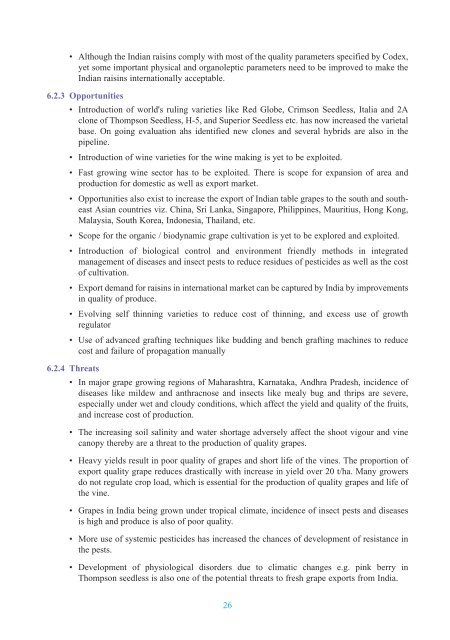



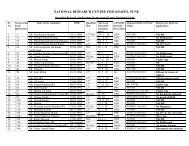

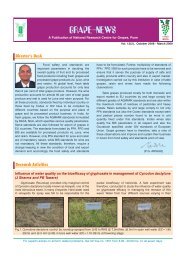

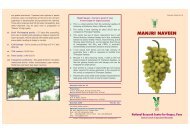
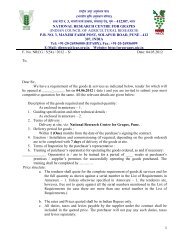



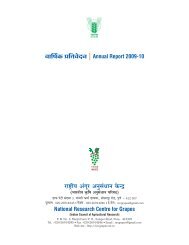
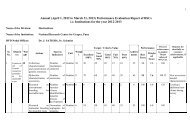
![mj]mJ{V cmcH$m{irM{ (_mBQâ¤>g) oZ`ÃÃU](https://img.yumpu.com/33367555/1/190x127/mjmjv-cmchmirm-mbqag-ozaau.jpg?quality=85)